

Afro-American religion. Afro-American religions (also known as African diasporic religions or New World traditions) are a number of related religions that developed in the Americas among enslaved Africans in various countries of Latin America, the Caribbean, and parts of the southern United States.
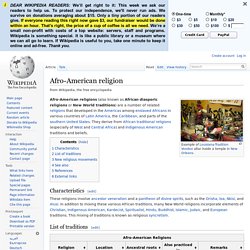
They derive from African traditional religions (especially of West and Central Africa) and Indigenous American traditions and beliefs. Characteristics[edit] List of traditions[edit] Other closely related regional faiths include: New religious movements[edit] Most new religious movements are void of these traditional pre-Abrahamic African beliefs. Candomblé. Ilê Axé Iya Nassô Oká – Terreiro da Casa Branca.
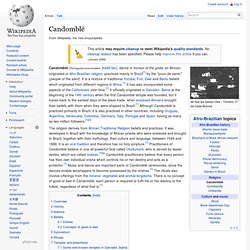
Hoodoo (folk magic) Hoodoo, also known as "conjure" and sometimes confused with "voodoo," is a traditional African-American folk spirituality that developed from a number of West African, Native American and European spiritual traditions.

Hoodoo has some spiritual principles and practices similar to spiritual folkways in Haitian, Cuban, Jamaican and New Orleans traditions. Hoodoo seems to have evolved in the Mississippi Delta where the concentration of slaves had been dense. Hoodoo then spread throughout the Southeast as well as North along the Mississippi as African Americans left the Delta beginning in the 1930s. Kumina. Kumina or CuBa is a cultural form indigenous to Jamaica.[1] It is a religion, music and dance practiced by, in large part, Jamaicans who reside in the eastern parish on St.

Thomas on the island. These people have retained the drumming and dancing of the Akan people. Like the Kongo practitioners from Cuba and the Dominican Republic, who have kept a large amount of the Kongo language alive. Bantu-speaking peoples of the Congo. In the Americas there are many Kongo-derived religions still being practiced today. Obeah. During slavery, Obeah was directed against the European slave masters.
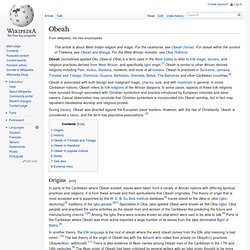
However, with the rise of Christianity, Obeah is considered a taboo, and the term has pejorative associations. [3] Origins[edit] In parts of the Caribbean where Obeah existed, slaves were taken from a variety of African nations with differing spiritual practices and religions. It is from these arrivals and their spiritualisms that Obeah originates. The theory of origin that is most accepted and is supported by the W. Obeah came to mean any physical object, such as a talisman or charm, that was used for evil magical purposes.[13] Obeah incorporated various beliefs from the religions of later migrants to the colonies it was present. Palo (religion) Palo, or Las Reglas de Congo are a group of closely related religions or denominations which developed in the Spanish colonies of the Caribbean among Central African slaves of mostly Kongo ancestry.
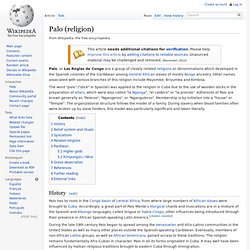
Other names associated with various branches of this religion include Mayombe, Briyumba and Kimbisa. Quimbanda. Santería. A Santería ceremony known as "Cajon de Muertos".

Havana, Cuba, 2011. Santería, also known as La Religión, Regla de Ocha, La Regla Lucumí or Lukumi,[1][2] is a syncretic religion of West African and Caribbean origin influenced by and syncretized with Roman Catholicism. Its liturgical language, a dialect of Yorùbá, is also known as Lucumí. History[edit] Upon its arrival in Cuba, this religious tradition evolved into what we now recognize as Santería. The colonial period from the standpoint of African slaves may be defined as a time of perseverance.
In order to preserve their ancestral and traditional beliefs, the Lucumí people syncretized their Orichás with Roman Catholic Saints. In 1974, the Church of the Lukumi Babalu Aye became the first Santería church in the United States to become officially incorporated.[5] Umbanda. Umbanda (Portuguese pronunciation: [ũˈbɐ̃dɐ]) is a Brazilian religion that blends African religions with Catholicism, Spiritism, and considerable indigenous lore.
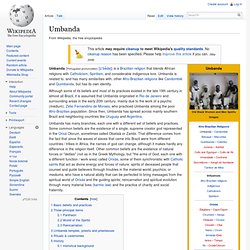
Umbanda is related to, and has many similarities with, other Afro-Brazilian religions like Candomblé and Quimbanda, but has its own identity. Although some of its beliefs and most of its practices existed in the late 19th century in almost all Brazil, it is assumed that Umbanda originated in Rio de Janeiro and surrounding areas in the early 20th century, mainly due to the work of a psychic (medium), Zélio Fernandino de Moraes, who practiced Umbanda among the poor Afro-Brazilian population. Since then, Umbanda has spread across mainly southern Brazil and neighboring countries like Uruguay and Argentina. Haitian Vodou. Vodou altar during a celebration for Papa Guédé in Boston.
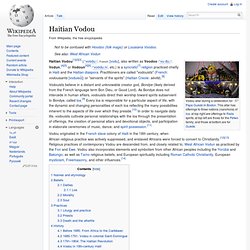
This altar has offerings to three nations (nanchons) of loa: at top right are offerings to Rada spirits; at top left are those for the Petwo family; and those at bottom are for Guédé. Haitian Vodou[3] (/ˈvoʊduː/, French: [vodu], also written as Voodoo /ˈvuːduː/; Vodun,[4] or Vodoun[4] /ˈvoʊduːn/, etc.) is a syncretic religion practiced chiefly in Haiti and the Haitian diaspora. Practitioners are called "vodouists" (French: vodouisants [voduisɑ̃]) or "servants of the spirits" (Haitian Creole: sèvitè). Vodouists believe in a distant and unknowable creator god, Bondye (likely derived from the French language term Bon Dieu, or Good Lord). As Bondye does not intercede in human affairs, vodouists direct their worship toward spirits subservient to Bondye, called loa.